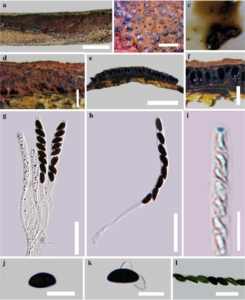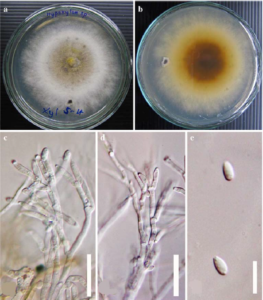Hypoxylon fendleri Berk. ex Cooke, Grevillea 11(no.60): 132 (1883).
Index Fungorum number: IF 206066; Facesoffunginumber: FoF00301, Figs. 1 and 2
Holotype – K 120974
Saprobic on wood, Sexual morph: Ascostromata 3–7 × 0.05–0.08 cm (x̄ = 5.3 × 0.07 cm), effuse-pulvinate, with inconspicuous to conspicuous perithecial mounds, surface brown vinaceous (84), dark vinaceous (82), dark brick (60), sepia (63) or, less frequently, bay (6); orange red granules immediately beneath surface and between perithecia, with KOHextractable pigments orange (7), the tissue below the perithecial layer inconspicuous, perithecia obovoid, 0.2–0.4 × 0.3–0.6 mm (x̄ = 0.3 × 0.5 mm), paraphyses not seen, ostioles lower than the stromatal surface. Asci (98–)100–156(–160) × (6.1–)6.5–10(–10.2) μm (x̄ = 143 × 8 μm, n = 20), 8-spored, unitunicate, cylindrical, pedicellate, with discoid apical ring bluing in Melzer’s reagent, 0.5–1.2 × 1.8–2.5 μm (x̄ = 0.9 × 2 μm, n = 20). Ascospores (9.5–)10–15(15.3) × (4.6–)5–7(–7.4) μm (x̄ = 14 × 6 μm, n = 30), uniseriate, one-celled, ellipsoid- inequilateral, with narrowly rounded ends, brown to dark brown, with sigmoid germ slit spore-length, perispore dehiscent in 10 % KOH, smooth or with inconspicuous coil-like ornamentation, epispore smooth. Asexual morph: Conidiogenous structure nodulisporium-like, arising from brownish, roughened masses. Conidiogenous cells hyaline, finely roughened, 10–20 × 2–3 μm (x̄ = 15 × 2.4 μm). Conidia hyaline, smooth to finely roughened-walled, ellipsoid, 4–6 × 2.5–4 μm (x̄ = 5 × 3.5 μm).
Culture characters – Colonies on OA at 25–28 °C covering 9 cm diam. Petri-dish in 3 weeks, at first white, becoming hazel (88) towards the centre, velvety, azonate, with diffuse margins, usually with vinaceous-buff (86) to isabelline (65) pigments diffusing beyond colonies; reverse amber (47) to grey olivaceous (107). Sporulating regions scattered over entire central of colony, brown-vinaceous (84).
Material examined – VENEZUELA, corticated wood, 1855, A. Fendler (K 120974, isotype); THAILAND, Chiang Mai, Doi Suthep, on decaying wood, 10 November 2012, D.A. Daranagama and K.D. Hyde AXL 039 (MFLU 12–0816), living culture, MFLUCC 12–0832; ibid., Chiang Rai, Doi Mae Salong, on dead bamboo clumps, 12 December 2012, D.A. Daranagama and K.D. Hyde AXL 055 (MFLU 12–0823), living cultures, MFLUCC 13–0104.
GenBank accession numbers– MFLUCC 12–0832: ITS: KM017563; LSU: KM017565; RPB2: KM017566;
Notes – Hypoxylon fendleri , H. trugodes and H. crocopeplum are taxa that share similar stromatal characters. These taxa have a wide distribution in the tropics and subtropics on a variety of host substrates. Hypoxylon fendleri is different in having unique vinaceous tone in stromatal extractable pigment colour. Hypoxylon fendleri is similar to H. trugodes, but differs in its orange extractable stromatal pigments (Ju and Rogers 1996). Hypoxylon fendleri is differentiated from H. crocopeplum by its vinaceous stromatal surfaces. However, some collections of H. fendleri lack vinaceous tones and hence were categorized under H. crocopeplum (Ju and Rogers 1996). The asexual morphs of these two taxa are quite different. While the former produces a nodulisporium-like conidial morph, the latter has a virgariella-like asexual morph (Ju and Rogers 1996). Hypoxylon subcrocopeplum can also be compared with H. fendleri. The sexual morph is similar to H. crocopeplum in having almost similar stromatal characters, but the perispore is indehiscent in the former species. Hypoxylon subcrocopeplum possesses a nodulisporium-like asexual morph, which is similar to H. fendleri. Both H. fendleri and H. subcrocopeplum have been recorded from New Zealand (Ju and Rogers 1996). Many of sequences from H. fendleri deposited in GenBank are from unpublished and unverified strains. In this study, we introduce new sequences including RPB2 from an authentic specimen.

Fig. 1 Hypoxylon fendleri (MFLU 12–0816) a Stromata in wood b Surface of stromata with ostioles c KOH extractable pigments d Side view of stromata e Cross section of stroma f Perithecia g Mature asci and immature asci in cluster h Mature asci in water i Asci in Melzer’s reagent with J+, discoid, apical apparatus j Mature ascospore with dehiscent perispore in KOH H Mature ascospores in water i Mature ascospore with straight germ slit. Scale bars: a=1 cm, b, c=1 mm, d, e=100μm, g-k=10μm.

Fig. 2 Hypoxylon fendleri on OA after 2 weeks a From above b From below c, d Conidiogenous structures e Conidia. Scale bars: c, d=30μm, e=5μm.
